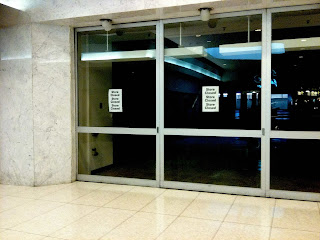The various ironies of dead shopping malls have been
well documented over the last ten years, as a number of the larger enclosed
centers have failed and the popular interest in things-abandoned has grown. In this
post, I wanted to show another aspect of suburban
decline.

For decades, artists, their studios, and the galleries that
show their work have sought low-rent neighborhoods in the cities in which to
work. As a result, the vibrant, active communities that often follow have
served to revitalize dying sections of the urban landscape. In nearly all
cases, however, the long-term benefit is enjoyed by real estate developers who
convert neighborhoods “colonized” by art and artists into upscale residential
and retail spaces. The end result is most often the displacement of the very
people (and the ideas) that reshaped the districts, and the replacement of
locally-owned businesses with corporate outlets. The story is an old chestnut
now. The burned-out building becomes an art gallery, and then the art gallery
becomes a Starbucks.
 |
| Unwanted coffee (note the graffiti). |
Not surprisingly, developers in the suburbs have
watched this process, and have attempted to transplant the phenomenon in a few
places where economic rot has crept into post-World War II communities. One
example is Crestwood Mall in suburban St. Louis. What had begun as a post-war
strip mall had become a sprawling enclosed shopping center by the 1980s, only
to become a suburban ghost town by the first years of the twenty-first century.

After occupancy fell below 50%, artists were invited
into the big climate-controlled space, and suddenly, what was once The Foot
Locker was a dance studio, what was once Waldenbooks was a community theater,
and what was a jewelry store became the site of an installational sculpture. For a
couple of years, the mall was transformed by the eclectic – something not
generally seen in such environments. It couldn’t last, however. Within a few
years, the leases of art-tenants were terminated, and the big place was
emptied. Word has it the mall will return to its mid-twentieth century roots as
an outdoor strip mall.
 |
| It wasn't a great piece, but it was a start. |
 |
| An unusual shopping mall directory: locally-owned shops and artist spaces down the aisle from The Gap. |
































